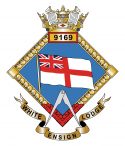
The Lodge Banner
The basic style of the banner is in the form of a Ship’s Crest.
Each different type of Ship has a different shape Crest, and therefore by looking at the Crest you can tell what vessel it is from.
The significance of the shape of the Diamond is that of a Shore Establishment or what is known in “Navy-speak” as a “Stone Frigate”.
Whatever the shape it is formed by a Rope and is usually painted Gold.
The whole is surmounted by the Navy Crown. This Crown was adopted over 300 years ago and is an emblematical representation of the battle with the Spanish Armada. You can identify the sails of the small English Ships between the large after-castles of the Spanish galleons as they proceed up the English Channel.
Usually, the Ship’s name was put on the block immediately under the Crown. In this instance, we have placed our Lodge Number, 9169.
The Square and Compasses have been added at 6 o’clock and are shown in the Third Degree.
An emblematical pictorial representation or the Ship’s name always fills the centre of the Crest. For us, it is the White Ensign flying from a jackstaff.
The background colour in the centre of the Crest is emblematical of the sea.
The name of the Lodge has been put in scrollwork underneath and clear of the emblem. The significance of the scrolling is that we have used the typical scrolling used on the Battle Honour board of any vessel or establishment.
The White Ensign can only be flown by warships in commission and is the cross of St. George defaced in the Upper Sinister Quadrant with the Union Flag. The symbolism of this is as follows:
“The three ensigns authorised to be worn by British ships are the Red, White and Blue Ensigns.
Up to and including the Tudor period the national colour for English ships was the St. George’s Cross.
From early in the 17th century the fleet of the Royal Navy was divided into Red, White and Blue Squadrons, and by the middle of that century the ships of these respective squadrons wore their “Colours”. In 1864 this system was discontinued and, by Acts of Parliament of 1864 and 1865, the White Ensign was authorised to be worn by all ships of the Royal Navy, the Red Ensign by merchant ships, and the Blue Ensign by ships belonging to public office and by ships of the colonial navies.
The White Ensign was probably allotted to the Royal Navy because ships had sailed under these colours in battle since 1800 including at the Battle of Trafalgar. The reason for wearing the White Ensign in battle in preference to the Red and Blue was to avoid the risk of confusion between the two latter with the French “tricolour”. A similar confusion between the White Ensign and the German Ensign arose in the First World War and so H.M. ships added the Union Flag; only called the “Union Jack” when flown from the staff at the stern or on the bowsprit by ships or vessels at anchor or alongside. It is only flown at sea when a ship or vessel is dressed overall, and Blue and Red Ensigns to ensure proper identification could be made.
(Admiralty Annual of Seamanship 1964 Volume 1)
